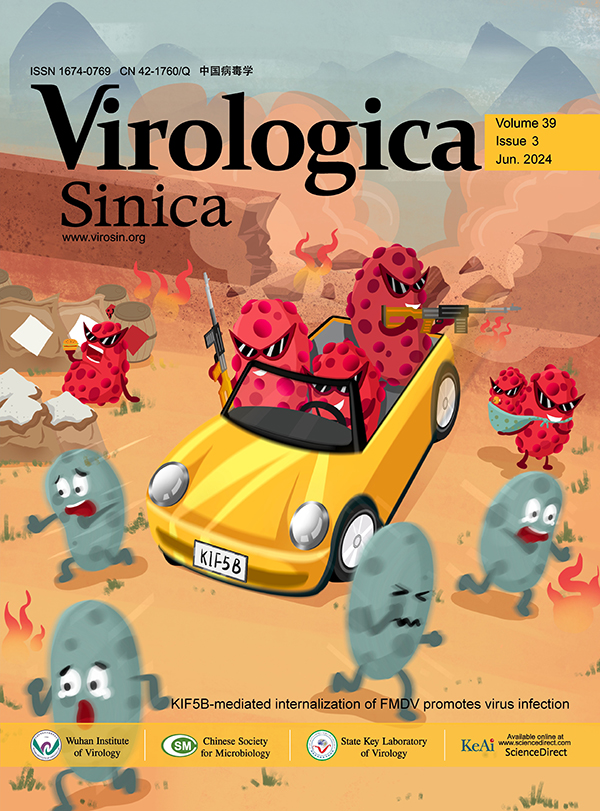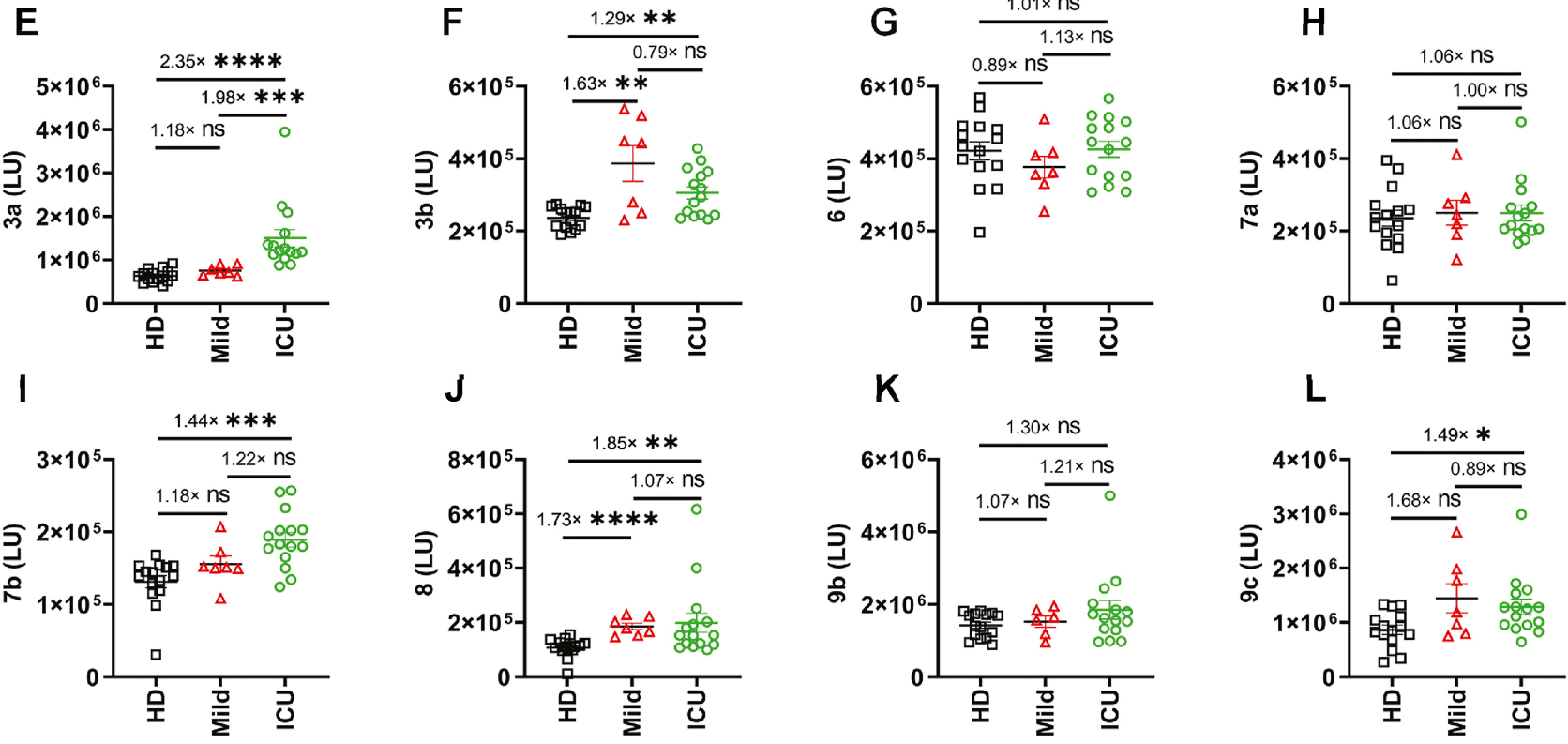-
Akerstrom, S., Tan, Y.J.,Mirazimi, A., 2006. Amino acids 15-28 in the ectodomain of SARS coronavirus 3a protein induces neutralizing antibodies. FEBS Lett., 580, 3799-3803.
-
Arshad, N., Laurent-Rolle, M., Ahmed, W.S., Hsu, J.C., Mitchell, S.M., Pawlak, J., Sengupta, D., Biswas, K.H.,Cresswell, P., 2022. SARS-CoV-2 accessory proteins ORF7a and ORF3a use distinct mechanisms to downregulate MHC-I surface expression. bioRxiv, 10.1101/2022.05.17.492198.
-
Bacher, P., Rosati, E., Esser, D., Martini, G.R., Saggau, C., Schiminsky, E., Dargvainiene, J., Schroder, I., Wieters, I., Khodamoradi, Y., Eberhardt, F., Vehreschild, M., Neb, H., Sonntagbauer, M., Conrad, C., Tran, F., Rosenstiel, P., Markewitz, R., Wandinger, K.P., Augustin, M., Rybniker, J., Kochanek, M., Leypoldt, F., Cornely, O.A., Koehler, P., Franke, A.,Scheffold, A., 2020. Low-avidity CD4(+) T cell responses to SARS-CoV-2 in unexposed individuals and humans with severe COVID-19. Immunity, 53, 1258-1271.e1255.
-
Blanco-Melo, D., Nilsson-Payant, B.E., Liu, W.C., Uhl, S., Hoagland, D., Moeller, R., Jordan, T.X., Oishi, K., Panis, M., Sachs, D., Wang, T.T., Schwartz, R.E., Lim, J.K., Albrecht, R.A.,Tenoever, B.R., 2020. Imbalanced host response to SARS-CoV-2 drives development of COVID-19. Cell, 181, 1036-1045.e1039.
-
Bojkova, D., Klann, K., Koch, B., Widera, M., Krause, D., Ciesek, S., Cinatl, J.,Munch, C., 2020. Proteomics of SARS-CoV-2-infected host cells reveals therapy targets. Nature, 583, 469-472.
-
Burbelo, P.D., Ching, K.H., Klimavicz, C.M.,Iadarola, M.J., 2009. Antibody profiling by Luciferase Immunoprecipitation Systems (LIPS). J. Vis. Exp., 10.3791/1549.
-
Deming, D., Sheahan, T., Heise, M., Yount, B., Davis, N., Sims, A., Suthar, M., Harkema, J., Whitmore, A., Pickles, R., West, A., Donaldson, E., Curtis, K., Johnston, R.,Baric, R., 2006. Vaccine efficacy in senescent mice challenged with recombinant SARS-CoV bearing epidemic and zoonotic spike variants. PLoS Med., 3, e525.
-
Gordon, D.E., Jang, G.M., Bouhaddou, M., Xu, J., Obernier, K., White, K.M., O'Meara, M.J., Rezelj, V.V., Guo, J.Z., Swaney, D.L., et al., 2020. A SARS-CoV-2 protein interaction map reveals targets for drug repurposing. Nature, 583, 459-468.
-
Hachim, A., Gu, H., Kavian, O., Kwan, M.Y., Chan, W.H., Yau, Y.S., Chiu, S.S., Tsang, O.T., Hui, D.S., Ma, F., Lau, E.H., Cheng, S.M., Poon, L.L., Peiris, J.M., Valkenburg, S.A.,Kavian, N., 2021. The SARS-CoV-2 antibody landscape is lower in magnitude for structural proteins, diversified for accessory proteins and stable long-term in children. medRxiv, 10.1101/2021.01.03.21249180.
-
Hachim, A., Gu, H., Kavian, O., Mori, M., Kwan, M.Y.W., Chan, W.H., Yau, Y.S., Chiu, S.S., Tsang, O.T.Y., Hui, D.S.C., Mok, C.K.P., Ma, F.N.L., Lau, E.H.Y., Amarasinghe, G.K., Qavi, A.J., Cheng, S.M.S., Poon, L.L.M., Peiris, J.S.M., Valkenburg, S.A.,Kavian, N., 2022. SARS-CoV-2 accessory proteins reveal distinct serological signatures in children. Nat. Commun., 13, 2951.
-
Hachim, A., Kavian, N., Cohen, C.A., Chin, A.W.H., Chu, D.K.W., Mok, C.K.P., Tsang, O.T.Y., Yeung, Y.C., Perera, R., Poon, L.L.M., Peiris, J.S.M.,Valkenburg, S.A., 2020. ORF8 and ORF3b antibodies are accurate serological markers of early and late SARS-CoV-2 infection. Nat. Immunol., 21, 1293-1301.
-
Han, L., Zhuang, M.W., Deng, J., Zheng, Y., Zhang, J., Nan, M.L., Zhang, X.J., Gao, C.,Wang, P.H., 2021. SARS-CoV-2 ORF9b antagonizes type I and III interferons by targeting multiple components of the RIG-I/MDA-5-MAVS, TLR3-TRIF, and cGAS-STING signaling pathways. J. Med. Virol., 93, 5376-5389.
-
Huang, C., Ito, N., Tseng, C.T.,Makino, S., 2006. Severe acute respiratory syndrome coronavirus 7a accessory protein is a viral structural protein. J. Virol., 80, 7287-7294.
-
Huang, C., Wang, Y., Li, X., Ren, L., Zhao, J., Hu, Y., Zhang, L., Fan, G., Xu, J., Gu, X., Cheng, Z., Yu, T., Xia, J., Wei, Y., Wu, W., Xie, X., Yin, W., Li, H., Liu, M., Xiao, Y., Gao, H., Guo, L., Xie, J., Wang, G., Jiang, R., Gao, Z., Jin, Q., Wang, J.,Cao, B., 2020. Clinical features of patients infected with 2019 novel coronavirus in Wuhan, China. Lancet, 395, 497-506.
-
Ito, N., Mossel, E.C., Narayanan, K., Popov, V.L., Huang, C., Inoue, T., Peters, C.J.,Makino, S., 2005. Severe acute respiratory syndrome coronavirus 3a protein is a viral structural protein. J. Virol., 79, 3182-3186.
-
Jiang, H.W., Zhang, H.N., Meng, Q.F., Xie, J., Li, Y., Chen, H., Zheng, Y.X., Wang, X.N., Qi, H., Zhang, J., Wang, P.H., Han, Z.G.,Tao, S.C., 2020. SARS-CoV-2 Orf9b suppresses type I interferon responses by targeting TOM70. Cell. Mol. Immunol., 17, 998-1000.
-
Kim, D., Lee, J.Y., Yang, J.S., Kim, J.W., Kim, V.N.,Chang, H., 2020. The architecture of SARS-CoV-2 transcriptome. Cell, 181, 914-921.e910.
-
Konno, Y., Kimura, I., Uriu, K., Fukushi, M., Irie, T., Koyanagi, Y., Sauter, D., Gifford, R.J., Nakagawa, S.,Sato, K., 2020. SARS-CoV-2 ORF3b is a potent interferon antagonist whose activity is increased by a naturally occurring elongation variant. Cell Rep., 32, 108185.
-
Lam, J.Y., Yuen, C.K., Ip, J.D., Wong, W.M., To, K.K., Yuen, K.Y.,Kok, K.H., 2020. Loss of orf3b in the circulating SARS-CoV-2 strains. Emerg. Microbes Infect., 9, 2685-2696.
-
Li, J.Y., Liao, C.H., Wang, Q., Tan, Y.J., Luo, R., Qiu, Y.,Ge, X.Y., 2020. The ORF6, ORF8 and nucleocapsid proteins of SARS-CoV-2 inhibit type I interferon signaling pathway. Virus Res., 286, 198074.
-
Li, Y., Xu, Z., Lei, Q., Lai, D.Y., Hou, H., Jiang, H.W., Zheng, Y.X., Wang, X.N., Wu, J., Ma, M.L., Zhang, B., Chen, H., Yu, C., Xue, J.B., Zhang, H.N., Qi, H., Guo, S.J., Zhang, Y., Lin, X., Yao, Z., Sheng, H., Sun, Z., Wang, F., Fan, X.,Tao, S.C., 2021. Antibody landscape against SARS-CoV-2 reveals significant differences between non-structural/accessory and structural proteins. Cell Rep., 36, 109391.
-
Liu, T., Jia, P., Fang, B.,Zhao, Z., 2020. Differential expression of viral transcripts from single-cell RNA sequencing of moderate and severe COVID-19 patients and its implications for case severity. Front. Microbiol., 11, 603509.
-
Matsuoka, K., Imahashi, N., Ohno, M., Ode, H., Nakata, Y., Kubota, M., Sugimoto, A., Imahashi, M., Yokomaku, Y.,Iwatani, Y., 2022. SARS-CoV-2 accessory protein ORF8 is secreted extracellularly as a glycoprotein homodimer. J. Biol. Chem., 298, 101724.
-
Minakshi, R., Padhan, K., Rani, M., Khan, N., Ahmad, F.,Jameel, S., 2009. The SARS Coronavirus 3a protein causes endoplasmic reticulum stress and induces ligand-independent downregulation of the type 1 interferon receptor. PLoS One, 4, e8342.
-
Miorin, L., Kehrer, T., Sanchez-Aparicio, M.T., Zhang, K., Cohen, P., Patel, R.S., Cupic, A., Makio, T., Mei, M., Moreno, E., Danziger, O., White, K.M., Rathnasinghe, R., Uccellini, M., Gao, S., Aydillo, T., Mena, I., Yin, X., Martin-Sancho, L., Krogan, N.J., Chanda, S.K., Schotsaert, M., Wozniak, R.W., Ren, Y., Rosenberg, B.R., Fontoura, B.M.A.,Garcia-Sastre, A., 2020. SARS-CoV-2 Orf6 hijacks Nup98 to block STAT nuclear import and antagonize interferon signaling. Proc. Natl. Acad. Sci. U. S. A., 117, 28344-28354.
-
Pushko, P., Parker, M., Ludwig, G.V., Davis, N.L., Johnston, R.E.,Smith, J.F., 1997. Replicon-helper systems from attenuated Venezuelan equine encephalitis virus: expression of heterologous genes in vitro and immunization against heterologous pathogens in vivo. Virology, 239, 389-401.
-
Qin, C., Zhou, L., Hu, Z., Zhang, S., Yang, S., Tao, Y., Xie, C., Ma, K., Shang, K., Wang, W.,Tian, D.S., 2020. Dysregulation of immune response in patients with coronavirus 2019 (COVID-19) in Wuhan, China. Clin. Infect. Dis., 71, 762-768.
-
Ren, Y., Shu, T., Wu, D., Mu, J., Wang, C., Huang, M., Han, Y., Zhang, X.Y., Zhou, W., Qiu, Y.,Zhou, X., 2020. The ORF3a protein of SARS-CoV-2 induces apoptosis in cells. Cell. Mol. Immunol., 17, 881-883.
-
Sharma, K., Akerstrom, S., Sharma, A.K., Chow, V.T., Teow, S., Abrenica, B., Booth, S.A., Booth, T.F., Mirazimi, A.,Lal, S.K., 2011. SARS-CoV 9b protein diffuses into nucleus, undergoes active Crm1 mediated nucleocytoplasmic export and triggers apoptosis when retained in the nucleus. PLoS One, 6, e19436.
-
Sun, J., Zhuang, Z., Zheng, J., Li, K., Wong, R.L., Liu, D., Huang, J., He, J., Zhu, A., Zhao, J., Li, X., Xi, Y., Chen, R., Alshukairi, A.N., Chen, Z., Zhang, Z., Chen, C., Huang, X., Li, F., Lai, X., Chen, D., Wen, L., Zhuo, J., Zhang, Y., Wang, Y., Huang, S., Dai, J., Shi, Y., Zheng, K., Leidinger, M.R., Chen, J., Li, Y., Zhong, N., Meyerholz, D.K., Mccray, P.B., Jr., Perlman, S.,Zhao, J., 2020. Generation of a broadly useful model for COVID-19 pathogenesis, vaccination, and treatment. Cell, 182, 734-743.e735.
-
Tan, M., Liu, Y., Zhou, R., Deng, X., Li, F., Liang, K.,Shi, Y., 2020. Immunopathological characteristics of coronavirus disease 2019 cases in Guangzhou, China. Immunology, 160, 261-268.
-
Tang, Z., Yu, P., Guo, Q., Chen, M., Lei, Y., Zhou, L., Mai, W., Chen, L., Deng, M., Kong, W., Niu, C., Xiong, X., Li, W., Chen, C., Lai, C., Wang, Q., Li, B.,Ji, T., 2023. Clinical characteristics and host immunity responses of SARS-CoV-2 Omicron variant BA.2 with deletion of ORF7a, ORF7b and ORF8. Virol. J., 20, 106.
-
Wang, G., Guan, J., Li, G., Wu, F., Yang, Q., Huang, C., Shao, J., Xu, L., Guo, Z., Zhou, Q., Zhu, H.,Chen, Z., 2021. Effect of ORF7 of SARS-CoV-2 on the chemotaxis of monocytes and neutrophils in vitro. Dis. Markers, 2021, 6803510.
-
Wu, A., Peng, Y., Huang, B., Ding, X., Wang, X., Niu, P., Meng, J., Zhu, Z., Zhang, Z., Wang, J., Sheng, J., Quan, L., Xia, Z., Tan, W., Cheng, G., Jiang, T., 2020. Genome composition and divergence of the novel coronavirus (2019-nCoV) originating in China. Cell Host Microbe 27, 325–328.
-
Wu, F., Zhao, S., Yu, B., Chen, Y.M., Wang, W., Song, Z.G., Hu, Y., Tao, Z.W., Tian, J.H., Pei, Y.Y., Yuan, M.L., Zhang, Y.L., Dai, F.H., Liu, Y., Wang, Q.M., Zheng, J.J., Xu, L., Holmes, E.C.,Zhang, Y.Z., 2020. A new coronavirus associated with human respiratory disease in China. Nature, 579, 265-269.
-
Wu, J., Shi, Y., Pan, X., Wu, S., Hou, R., Zhang, Y., Zhong, T., Tang, H., Du, W., Wang, L., Wo, J., Mu, J., Qiu, Y., Yang, K., Zhang, L.K., Ye, B.C.,Qi, N., 2021. SARS-CoV-2 ORF9b inhibits RIG-I-MAVS antiviral signaling by interrupting K63-linked ubiquitination of NEMO. Cell Rep., 34, 108761.
-
Yang, R., Zhao, Q., Rao, J., Zeng, F., Yuan, S., Ji, M., Sun, X., Li, J., Yang, J., Cui, J., Jin, Z., Liu, L.,Liu, Z., 2021. SARS-CoV-2 accessory protein ORF7b mediates tumor necrosis factor-α-induced apoptosis in cells. Front. Microbiol., 12, 654709.
-
Zhang, J., Cruz-Cosme, R., Zhuang, M.W., Liu, D., Liu, Y., Teng, S., Wang, P.H.,Tang, Q., 2020. A systemic and molecular study of subcellular localization of SARS-CoV-2 proteins. Signal Transduct. Target. Ther., 5, 269.
-
Zhang, Y., Chen, Y., Li, Y., Huang, F., Luo, B., Yuan, Y., Xia, B., Ma, X., Yang, T., Yu, F., Liu, J., Liu, B., Song, Z., Chen, J., Yan, S., Wu, L., Pan, T., Zhang, X., Li, R., Huang, W., He, X., Xiao, F., Zhang, J.,Zhang, H., 2021. The ORF8 protein of SARS-CoV-2 mediates immune evasion through down-regulating MHC-Ι. Proc. Natl. Acad. Sci. U. S. A., 118.
-
Zhao, J., Zhao, J., Mangalam, A.K., Channappanavar, R., Fett, C., Meyerholz, D.K., Agnihothram, S., Baric, R.S., David, C.S.,Perlman, S., 2016. Airway memory CD4(+) T cells mediate protective immunity against emerging respiratory coronaviruses. Immunity, 44, 1379-1391.














 DownLoad:
DownLoad: